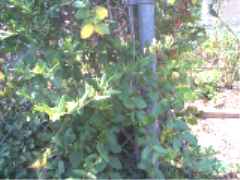 |
 |
|
|
|
 |
 |
|
|
|
The mention of honeysuckle summons dual emotions. My good memories fade back to summer days as a youngster, riding my bicycle down hot, dusty roads in the summertime. Time meant nothing and I would often waste hours (probably minutes in reality) resting by a fence row plucking the honeysuckle flowers, carefully pulling the plant's stamen through the throat of the flower, and delighting at the sweet flavor of the extracted nectar. The negative side is trying to find the fence in your back yard which you know you once owned.
Honeysuckle is generally represented by the genus Lonicera. As with many plants, these plants are native to Asia. Their introduction into the United States afforded them a vast land in which to romp. This deciduous vine has a wide range of hardiness and grows quickly in almost any light. Dry weather is not a problem as the plant tolerates all but swamp conditions. There are no significant pest problems. The plant is attractive to birds and bees, feasting and propagating. When the birds eat the fruit of many plants, the seed goes straight through their digestive tract in tact and is expelled with a natural coating of fertilizer somewhere in the range of their random flight pattern.
One cultivated species of honeysuckle is Lonicera tatarica which we sell in our nursery as an ornamental shrub. The plant makes a good hedge or screen, growing upright and out to a diameter of 8-10 feet. The deciduous foliage is deep green (sometimes blue-green) and the flowers can be white, pink, or red. The plant can be maintained to a reasonable size and does not tend to run free if cultivated. Your landscape would not be in danger because of this plant, but the birds will spread the joy.
The other honeysuckle we are most familiar with is Lonicera japonica or Japanese Honeysuckle. This is the plant I encountered on the roadsides as a child. This is the plant that ate my chain link fence. This is the plant that cruises around in my flower beds and up the side of my oaks. This is the enemy. Clearly, you can tell I let the plant grow longer than I should have in my yard. Cobblers kids have holes in their shoes.
This spring I decided to deal with my honeysuckle. We sell very effective brush killers for woody vines such as honeysuckle. I went out to reclaim my fence, knowing I would have to dislodge the vines from the 2" chain linking. Armed with only pruners, I started mid way up on the fence, snipping larger stems and carefully pulling them out of the fence. Sometimes I had to cut stems as short as 6" because of the interweaving of the vine. In short order, I could see my fence as well as the roots of the vines, which were not as dense as one would think. The roots seemed to pull out of the moist soil with relative ease. Wha-la! In 30 minutes I had freed 25 feet of fence from honeysuckle bondage. This has been 3 months ago and my fence is still honeysuckle free.
If you've read my columns previously, you know I am not an organic gardener. I will use herbicides and other pesticides. Many of us immediately seek out the best chemical for the job without any thought as to whether a pesticide is needed. In my case, a weed killer would have left me with a fence full of dead vines. I had to pull them out anyway. Weed killer was uncalled for in this case. It's not a bad idea, in all cases, to ask yourself, "Do I really need a pesticide this time?". Have a good week.
Andy Lynn